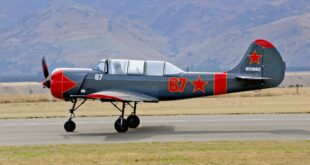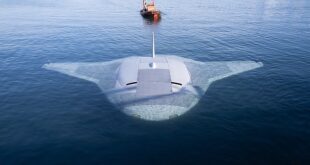By Erdal Ozkan, Ohio State University Extension
Traditionally, aerial spraying of pesticides has been done using conventional fixed-wing aircraft or helicopters with a pilot onboard. However, this is changing. Small, remotely piloted aircraft are being used to apply pesticides around the world, especially in Southeast Asia. For example, about 30% of all agricultural spraying in South Korea, and about 40% of Japan’s rice crop, is sprayed using drones. In contrast, drone spraying is in its infancy in the United States, but interest in this technology from pesticide applicators is steadily increasing.
A variety of names and the acronyms are associated with remotely piloted aircraft. Most used ones are: Unmanned Aerial Vehicle (UAV) and Unmanned Aerial System (UAS). However, the name used most commonly by the general public is “drone.” Drones entered the agriculture scene initially for non-spraying applications, such as crop and field-condition data collection to increase profitability in crop production. Drones successfully and effectively monitor plant growth by collecting and delivering real-time data from the moment of plant emergence to harvest. With the help of fast and accurate GPS or GNNS technology, a high-resolution camera, and variable flying speeds and altitudes, drones can provide a wealth of information on the condition of every half square inch of crop or soil.
Using drones for spraying pesticides is becoming attractive mainly for four reasons: 1) The topography or soil conditions do not allow the use of traditional ground sprayers or conventional agricultural aircraft, 2) when airplanes and helicopters are not available or are too expensive to use, 3) drones more efficiently spray small, irregular-shaped fields, 4) drones significantly reduce the risk of applicators being contaminated by the pesticides. There are also emerging problems, such as tar spot on corn, which may increase the need for aerial pesticide application by drones.
Although they are small, drone sprayers have all the components of large ground sprayers and conventional aerial sprayers. In addition, all drone sprayers are also equipped with a GPS or GNNS receiver and multiple sensors for collision avoidance. All drones also have wireless remote control for manual operation. Some drones can be operated on autopilot.
Types of spray drones
Spraying with a drone is not new. First used in Japan in 1997, the Yamaha RMax drone looks like a small helicopter. It has a single rotor with a diameter of about 10 feet, weighs 220 pounds, and has over 4 gallons of spray tank capacity. It is gasoline powered, can run for 1 hour before refueling, can be retrofitted with three or four nozzles, and was FAA-approved for use in California in 2015. The manufacturer does not sell the aircraft, rather they service it and provide a trained team (usually two to three people) to operate the aircraft.
A rapid proliferation of lighter, easy-to-operate drones for spraying pesticides is currently underway. They are lightweight but powerful enough to lift a 10- to 15-gallon tank. Most commercial spray drones today are the multi-rotor type.
The drones’ propellers create turbulence in the canopy, which significantly improves droplet penetration into lower parts of the canopy compared to traditional ground sprayers that are not air-assisted. Multi-rotor drones have similar components but can differ in many ways: number of rotors, rotor positions, nozzle locations and configurations, type and number of nozzles, distance between nozzles, vertical distance between the rotors and the nozzles under them. For example, most drones have nozzles located on the end of hoses descending a few inches below the rotors. A smaller percentage of drones have nozzles mounted on a boom. Drones with a boom, and especially those with booms extending beyond the rotors (photo below on the right) usually are not preferred. These drones are likely to become obsolete because of relatively poor spray coverage compared to the boomless spray drones. They also have a higher drift potential influenced by vortices that may appear near both ends of the boom. Having a larger number of nozzles on the boom, and having a boom that does not extend too far outside the rotors may help avoid this problem, resulting in much better penetration of spray droplets into the target plant canopy and a better coverage of the target surface with droplets.
One recent drone type has four rotor arms with two rotors on each arm powering a pair of relatively larger impellers that are stacked one on top of the other. This dual rotor configuration provides a more powerful lifting capacity and better flight dynamics. Another unique aspect of this drone is how the spray is discharged from the drone. It uses rotary atomizers positioned under the propellers. The spray droplets are produced by the rotational speed of a cup, which allows the spray mixture to be emitted using very low pressure. This design produces relatively uniform droplets as opposed to the wide range of droplet sizes produced by conventional flat-fan nozzles.
Operating characteristics of multi-rotor spray drones
The application rate of spray drones in row crops is usually 1.5 to 2 gallons per acre. The rate depends on many factors, but is mainly a function of the spray tank capacity, flying speed, spray swath width, number of nozzles or rotary atomizers on the drone, and the flow rate (volume sprayed per minute). For example, a 5-gallon tank may take 2–3 minutes to empty. Some drones have a tank sensor to indicate the liquid level. This sensor can also be programmed to pause spraying and return the drone to home base when the tank needs a refill. Once replenished, the drone flies back to continue spraying where it stopped. The maximum flying speed of multi-rotor drones varies between 10–30 miles per hour. They are usually flown 7–12 feet above the ground or crop canopy. Forestry applications may require the drone to fly at least 30 feet above the ground to avoid obstacles. All current models of drones have a terrain sensor that maintains the optimum flight height to spray uneven and hilly terrain and automatically navigate hills and slopes. Most spray drone models are compatible with Real Time Kinematics (RTK), which provides centimeter-level, locational precision during flight.
This article covered only the types of drones used for spraying pesticides. Additional information on this topic and other topics such as drone sprayer performance, best spraying practices using drones, limitations of spray drones and obstacles for their adoption, regulations related to using drones to spray pesticides, and resources for obtaining certificates to apply pesticides using drones, and future of spray drones are discussed in a new Ohio State University Extension Publication FABE-540 titled “Drones for Spraying Pesticides — Opportunities and Challenges.” The links to access this publication is: https://ohioline.osu.edu/factsheet/fabe-540. The PDF version of the publication is also available at: https://pested.osu.edu/sites/pested/files/imce/FABE-540.pdf.
 Unmanned Aerial Vehicle The latest drone news
Unmanned Aerial Vehicle The latest drone news




